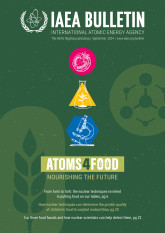
If you would like to learn more about the IAEA’s work, sign up for our weekly updates containing our most important news, multimedia and more.
Managing the New World screw worm using the sterile insect technique in Latin America
Rosalia Fraga Pazos

Participants at a regional workshop on emergency response to a New World screw worm outbreak, held in Costa Rica in March 2024. (Photo: F. Chaverri/SENASA)
A reinfestation of New World screw worm is emerging in Central America and the parasite is already endemic in South America. New World screw worm Cochliomyia hominivorax is a parasitic fly larva that feeds on the flesh of warm-blooded animals, including humans. Myiasis, an infection caused when the fly larva hatch in animal tissue, is endemic in some Caribbean islands and in most South American countries. It has a devastating effect on livestock production, resulting in higher mortality rates and decreased milk and meat yields. Until Costa Rica reported the first cases in cattle in July 2023, the entire Central American region, including Costa Rica, had been free of the disease.
A total of 14 countries in Latin America are being supported by the Joint FAO/IAEA Centre of Nuclear Techniques in Food and Agriculture (Joint FAO/IAEA Centre) to protect livestock and farmers’ livelihoods through the application of the sterile insect technique (SIT), an environmentally friendly pest control method that has been used successfully for over 60 years to tackle pests that harm livestock.
“ The main objective of this decree is to have the necessary inputs to prevent the spread of this disease in the national territory. The IAEA’s support for the transfer of nuclear technology to apply the SIT is essential to prevent, control and eradicate the disease.
The SIT involves sterilizing millions of male insects using ionizing radiation before releasing them into the wild to mate with wild females. As no offspring can be produced, the SIT leads to a drastic reduction in the wild population of the disease carrier while minimizing the use of pesticides.
As part of this approach, the IAEA is providing specialized training in the SIT, in addition to knowledge transfer and training, and a regional IAEA technical cooperation project is supporting the procurement of technical equipment and supplies.
Following the re-emergence of the New World screw worm, which threatens the region’s livestock and food security, Costa Rica declared a sanitary emergency on 7 February 2024 in an attempt to control the spread of the parasite.
“The main objective of this decree is to have the necessary inputs to prevent the spread of this disease in the national territory,” says Luis Matamoros, Director General of Costa Rica’s National Animal Health Service (SENASA), which is part of the Ministry of Agriculture. “The IAEA’s support for the transfer of nuclear technology to apply the SIT is essential to prevent, control and eradicate the disease.”
In March 2024, the IAEA organized a regional emergency response workshop in Costa Rica in collaboration with SENASA, the Food and Agriculture Organization of the United Nations, the Inter-American Institute for Cooperation on Agriculture, the Regional International Organization for Plant Protection and Animal Health, and the USA-Panama Commission for the Eradication and Prevention of the New World Screwworm.
“This workshop was absolutely crucial,” says Walther Enkerlin, an entomologist at the Joint FAO/IAEA Centre. “Participants from national animal health services from across the region shared knowledge, strategies and resources. The goal was to develop a robust system for early detection, treatment methods and rapid response to control the New World screw worm infestation and promote its eradication using the SIT.”
“Thanks to the training sessions supported by the IAEA’s technical cooperation programme, I now feel confident in diagnosing New World screw worm at both the adult and larvae stages and in applying effective eradication methods,” says Maria Gabriela Mejia, a participant from Honduras.
The IAEA continues to work closely with national animal health services across Latin America to facilitate the implementation of the SIT. It is sharing expertise on the comprehensive management of the pest and providing laboratory equipment and supplies. Moreover, the IAEA is assisting in the development of technical documents which will help to inform decision making by national authorities on applying the SIT as part of an area-wide integrated pest management approach.

